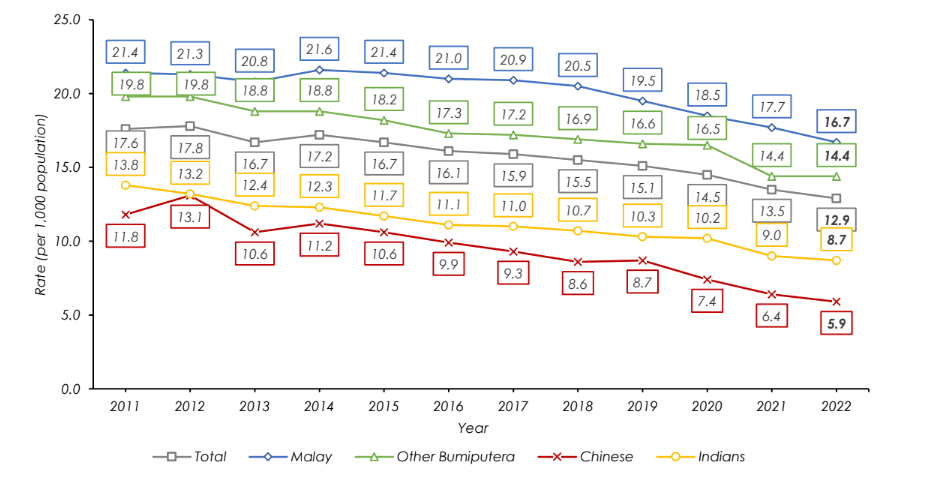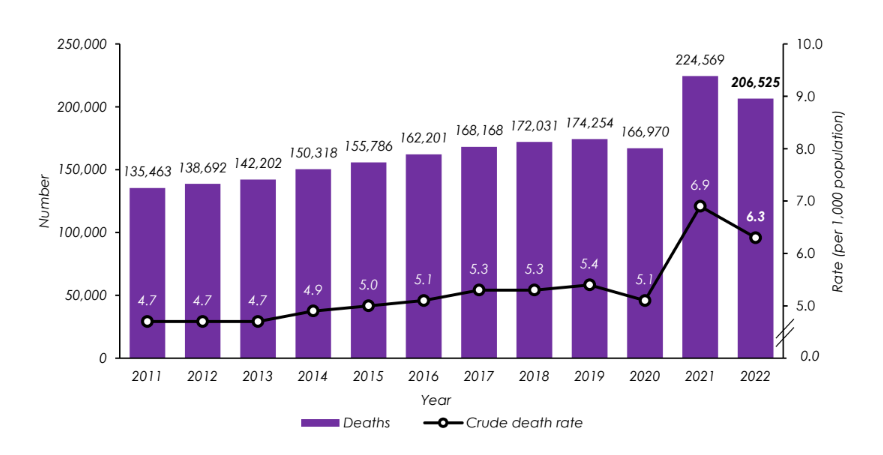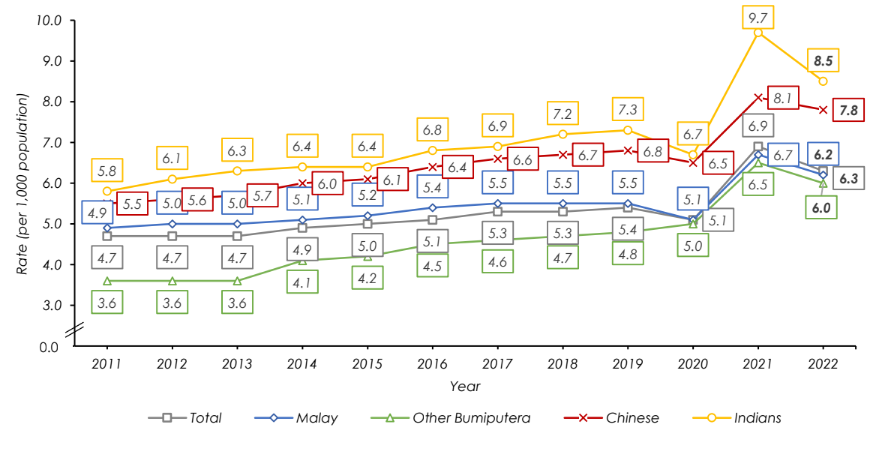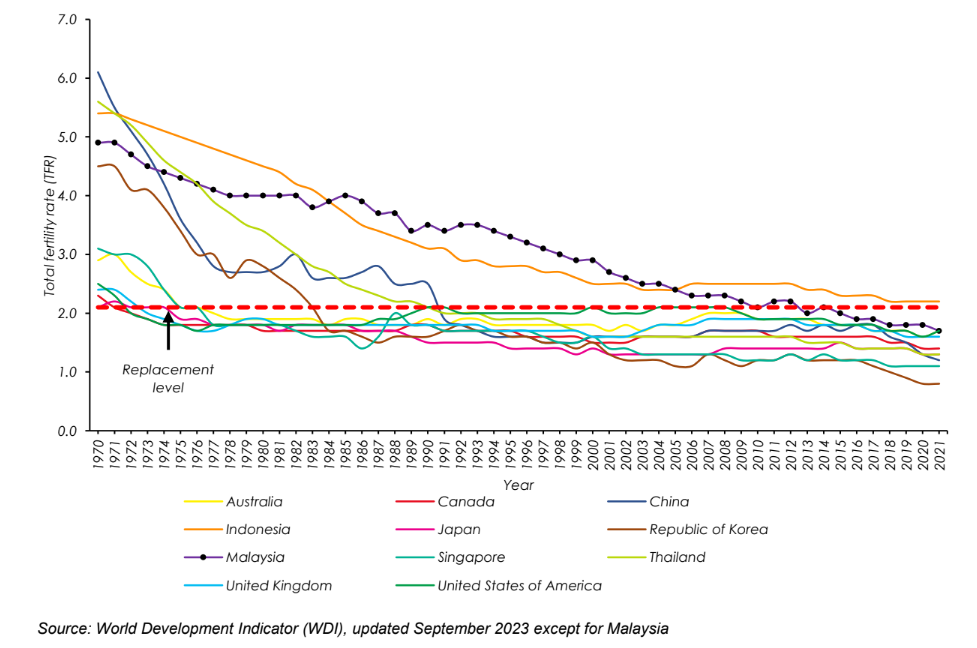Released today, the 2023 Vital Statistics report from the Department of Statistics, Malaysia, offers a comprehensive overview of birth and death statistics for the year 2022. The data is meticulously categorized by demographic characteristics at the national, state, and administrative district levels. These statistics, which capture pivotal life events, play a pivotal role in informing policy decisions and guiding the development of programs in areas such as population management, healthcare, education, employment, and various other sectors.
Dato’ Sri Dr. Mohd Uzir Mahidin, Chief Statistician Malaysia, highlighted that “the total fertility rate (TFR) in 2022 declined to 1.6 children for every woman aged 15–49 years as compared to 1.7 children in 2021. This fertility rate was the lowest in five decades.
4.9 children per woman in 1970 Since 1970 up to 2012, the national TFR was still above the replacement level of 2.1 children, which indicates that the average number of children born per woman throughout her reproductive life has been sufficient to replace herself and her partner. However, the TFR started to decline below the replacement level from 2013 onwards. This declining trend in fertility rate is signaling the potential for a demographic crisis, such as population growth shrinking, an aging population, and economic and social implications. Based on the Principles and Recommendations for A Vital Statistics (Revision 3), United Nations Statistics Division (2014) manual, the replacement level of 2.1 children is the average number of children a woman would need to give birth by bearing a daughter who survives to childbearing age. If the replacement level of fertility is sustained over a sufficiently long period, each generation will exactly replace herself and her partner regardless of population migration”.
For the period of 2011 to 2022, the TFR for all major ethnic groups in Malaysia has shown a declining trend. The highest TFR was recorded by Malay, with 2.1 children per woman aged 15–49 years. Meanwhile, Chinese recorded the lowest TFR of 0.8 children. At the state level, all states recorded TFR below the replacement level except three, namely Terengganu (2.9 children), Kelantan (2.7 children), and Pahang (2.1 children).
Malaysia, along with several developed countries such as the United States of America (1.7 children), Australia (1.7 children), the United Kingdom (1.6 children), Japan (1.3 children), and the Republic of Korea (0.8 children), have observed a trend of fertility rates falling below the replacement level. Similar trends have also been observed in ASEAN countries, namely Viet Nam (1.9 children), Brunei Darussalam (1.8 children), Thailand (1.3 children), and Singapore (1.1 children), while the Philippines (2.7 children), Lao PDR (2.5 children), Cambodia (2.3 children), Indonesia (2.2 children), and Myanmar (2.2 children) were above the replacement level.
For the past five decades, TFR has been declining in all selected countries, with a varying declining pace according to their level of fertility. There are few countries that have faced a decline in the level of TFR below the level much earlier, namely the United Kingdom (1973: 2.0 children), Japan (1975: 1.9 children), and France.
(1976: 2.0 children), Australia (1977: 2.0 children), and Singapore (1977: 1.8 children). Therefore, France and the United Kingdom have proactively responded to the issue of declining TFR, which could potentially lead to a demographic crisis. They have pursued a strategy of increased migration to bolster their population numbers and labor forces. This approach aims to mitigate the potential economic and demographic challenges associated with declining fertility rates, such as aging populations and labor shortages.
Meanwhile, he also added, “The number of live births was 423,124 births in 2022, a decrease of 3.8 percent (16,620 births) as compared to 439,744 births in 2021. More male newborns were recorded than females, with 218,345 and 204,779, respectively.
The decline in the number of live births has contributed to the decline in the crude birth rate (CBR) from 13.5 births in 2021 to 12.9 births per thousand population in 2022.
All states recorded a decrease in CBR in 2022 as compared to 2021 except for Sabah, which showed an increase from 12.2 (2021) births to 12.8 (2022) births per thousand population. This report also presents the number of live births and CBR at the administrative district level in Malaysia. The highest CBR in 2022 was recorded by the districts of Song, Sarawak, and Kuala Terengganu, Terengganu, with both districts recording 4.3 births per thousand population. Meanwhile, Kinabatangan, Sabah, recorded the lowest rate of 4.6 births.
Dato’ Sri Dr. Mohd Uzir Mahidin also said, “The number of deaths in 2022 was 206,525 deaths, a decrease of 8.0 percent (18,044 deaths) as compared to 224,569 deaths in 2021 after the COVID-19 pandemic. The crude death rate (CDR) also recorded a decrease from 6.9 (2021) to 6.3 (2022) deaths per thousand population. The number of male deaths in 2022 was 117,790, or 57.0 percent of the total deaths. Meanwhile, female deaths were 88,735 (43.0%)”.
Besides that, CDR for most states decreased in 2022 as compared to 2021, except Perlis, Pahang, Perak, and Terengganu. W.P. Kuala Lumpur recorded the highest decrease of 1.7 points, from 6.8 (2021) deaths to 5.1 (2022) deaths per thousand population. Looking at the administrative district level, Kanowit and Song, Sarawak, recorded the highest CDR in 2022 with 14.3 deaths per thousand population, followed by Bukit Mabong, Sarawak (13.0), Selama, Perak (12.2), and Maradong, Sarawak (12.0). Meanwhile, the Kinabatangan district in Sabah recorded the lowest CDR with 1.9 deaths per thousand population, followed by Kalabakan, Sabah (2.0), and Samarahan, Sarawak (2.4).
He added, “All age groups recorded a decrease in the number of deaths except those aged 0–14 years, which increased from 4,115 deaths to 4,754 deaths in 2022. The number of deaths aged 41–59 recorded the highest decrease, with a 20.4 percent decrease from 52,282 (2021) deaths to 41,640 deaths in 2022. Besides, the number of deaths for aged
15–40 years and 60 years and over also recorded a decrease from 17,953 deaths to 14,830 deaths and 150,219 deaths to 145,301 deaths, respectively”.
DOSM has launched OpenDOSM NextGen as a medium that provides a catalog of data and visualization to facilitate users in analyzing various data. OpenDOSM NextGen is an open-source data sharing platform accessible through the https://open.dosm.gov.my portal.
The Government of Malaysia has declared National Statistics Day (MyStats Day) on October 20 each year. MyStats Day theme is “Statistics is the Essence of Life”.
Chart 1:Live births and crude birth rate, Malaysia, 2011-2022.

Chart 2: Crude birth rate by major ethnic group, Malaysia, 2011-2022.

Chart 3: Total fertility rate, Malaysia, 1970-2022.

Chart 4: Total fertility rate by major ethnic group, Malaysia, 2011-2022.

Chart 5: Deaths and crude death rate, Malaysia, 2011-2022.

Chart 6: Crude death rate rate by major ethnic group, Malaysia, 2011-2022.

Chart 7:Deaths by age group group, Malaysia, 2021 and 2022.

Chart 8: Total fertility rate (TFR) by selected countries, 1970–2021.
